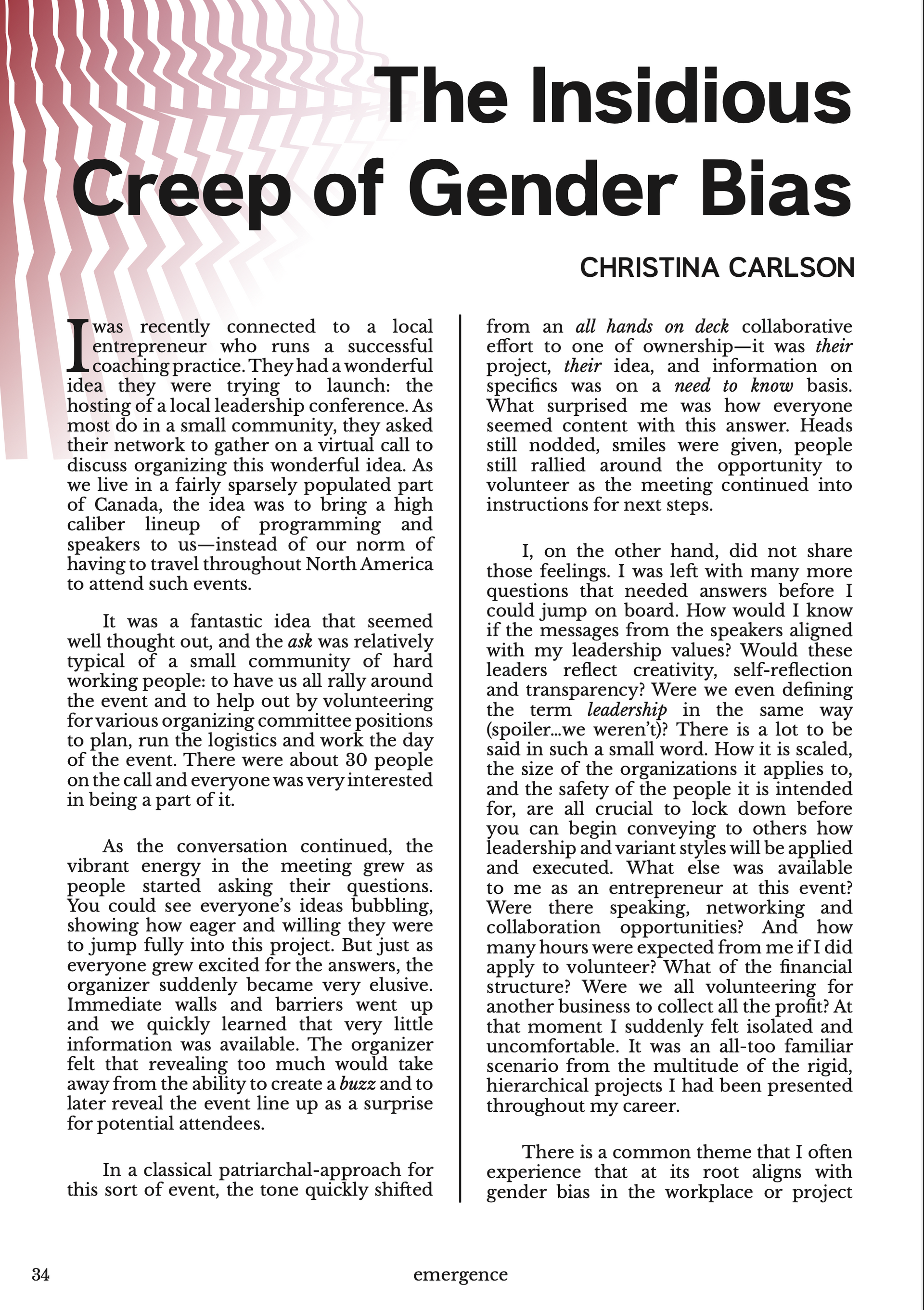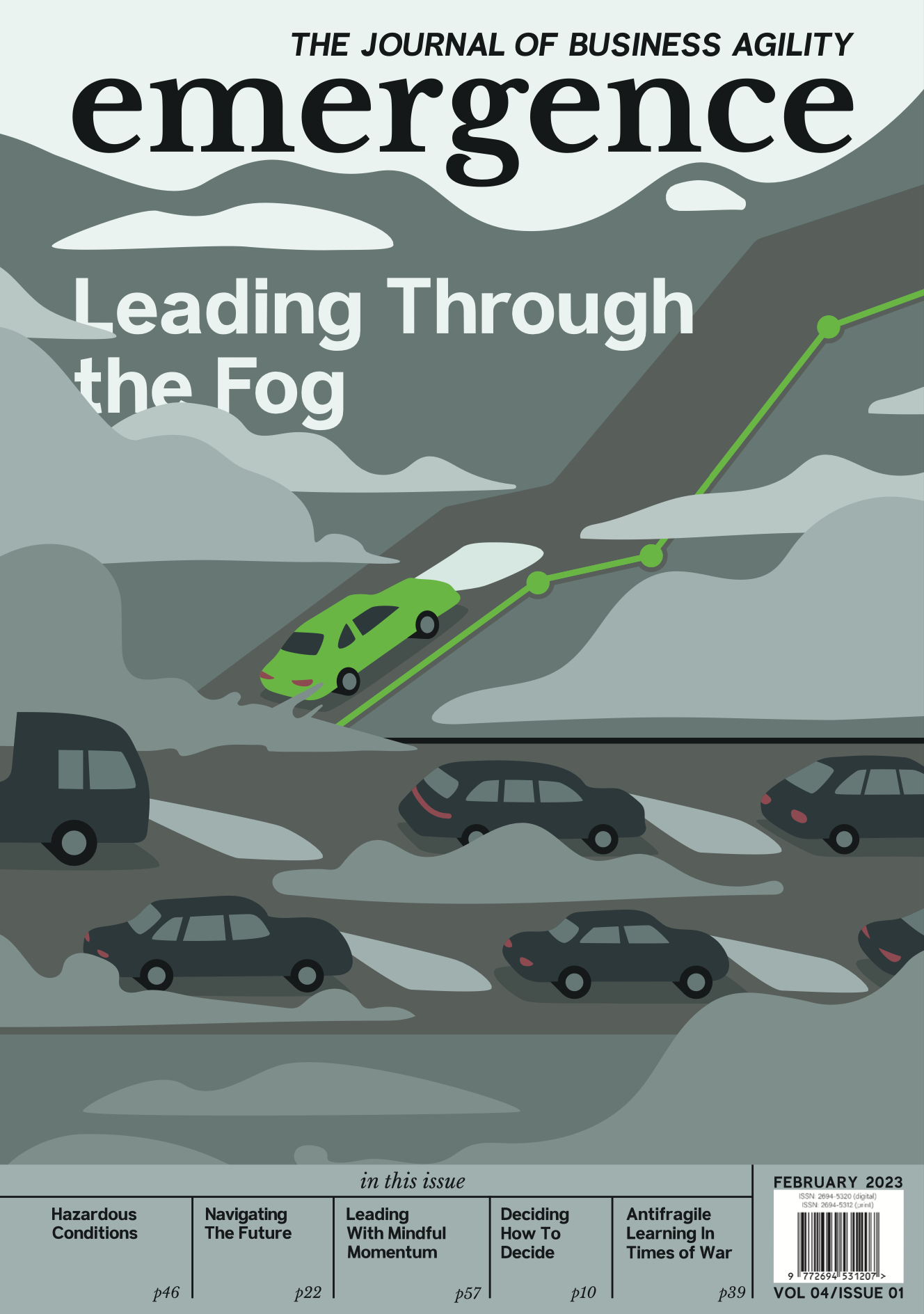The Insidious Creep of Gender Bias
I was recently connected to a local entrepreneur who runs a successful coaching practice. They had a wonderful
idea they were trying to launch: the hosting of a local leadership conference. As most do in a small community, they asked their network to gather on a virtual call to discuss organizing this wonderful idea. As we live in a fairly sparsely populated part of Canada, the idea was to bring a high caliber lineup of programming and speakers to us—instead of our norm of having to travel throughout North America to attend such events.
It was a fantastic idea that seemed well thought out, and the
ask
was relatively typical of a small community of hard working people: to have us all rally around the event and to help out by volunteering for various organizing committee positions to plan, run the logistics and work the day of the event. There were about 30 people on the call and everyone was very interested in being a part of it.
As the conversation continued, the vibrant energy in the meeting grew as people started asking their questions. You could see everyone’s ideas bubbling, showing how eager and willing they were to jump fully into this project. But just as everyone grew excited for the answers, the organizer suddenly became very elusive. Immediate walls and barriers went up and we quickly learned that very little information was available. The organizer felt that revealing too much would take away from the ability to create a buzz and to later reveal the event line up as a surprise for potential attendees.
In a classical patriarchal-approach for this sort of event, the tone quickly shifted from an
all hands on deck
collaborative effort to one of ownership—it was
their
project,
their
idea, and information on specifics was on a
need to know
basis. What surprised me was how everyone seemed content with this answer. Heads still nodded, smiles were given, people still rallied around the opportunity to volunteer as the meeting continued into instructions for next steps.
I, on the other hand, did not share those feelings. I was left with many more questions that needed answers before I could jump on board. How would I know if the messages from the speakers aligned with my leadership values? Would these leaders reflect creativity, self-reflection and transparency? Were we even defining the term
leadership
in the same way (spoiler...we weren’t)? There is a lot to be said in such a small word. How it is scaled, the size of the organizations it applies to, and the safety of the people it is intended for, are all crucial to lock down before you can begin conveying to others how leadership and variant styles will be applied and executed. What else was available to me as an entrepreneur at this event? Were there speaking, networking and collaboration opportunities? And how many hours were expected from me if I did apply to volunteer? What of the financial structure? Were we all volunteering for another business to collect all the profit? At that moment I suddenly felt isolated and uncomfortable. It was an all-too familiar scenario from the multitude of the rigid, hierarchical projects I had been presented throughout my career.
There is a common theme that I often experience that at its root aligns with gender bias in the workplace or project environment. To me, in this specific scenario, the pieces of the puzzle depicted a familiar picture of a gender bias but were executed in a new way. First off, the organizer of this proposed conference had made a purposeful decision to gather a group made up of 99% women in order to get this project off the ground. On the surface, these demographics appeared to be shattering traditional gender bias; gathering so many women together disrupted typical stereotypes of women being less competent than men. It was an opportunity to hold women to a higher performance standard, and didn’t assume their traditional lack of access to powerful networks to make the event a success (Wynn, A.T., Correll, S.J. 2018).
This makes sense to me, as we’ve come a long way from the traditional definitions of gender bias and are increasingly embracing the positive characteristics women bring as leaders. For example, according to the Pew Research Centre (2008) women can be more honest, are smarter, more compassionate, and more creative than their male counterparts. In my story, the organizer gathered women together because they supported the initiative, similarly to the Pew Research Centre (2008) that when a job needs to get done often women are the go-to persons to execute. The outcomes needed to pull together such a prestigious event aligned also with research from Zenger and Folkman (2019) who found that women are more capable than men in the areas of: taking initiative, resilience, developing others, driving for results, building relationships, collaboration and teamwork, establishing stretch goals, communicating powerfully and prolifically, solving problems and analyzing issues, (which fit in well with the volunteer positions needed for this leadership conference initiative).
But I saw this experience as a new way in which gender bias can show up in our organizations—which is maybe not in the way you’d imagine. It reflected how, even though our workplaces and other organizations operate differently in the twenty-first century than in the past, new ways of operating are still built around structures and practices that advantage the people at the top of a patriarch-type of leadership style (Correll, S.J., 2017). On the surface it seemed reasonable to gather these women together, but it’s becoming normal for me to experience a situation where the context changes as soon as we’ve committed to the work. A leader says:
I will hype you up because you have the skills and capacity to do all the work I need to execute this flawlessly, then quickly shift to
this is my gig, my idea and you will do as your told with the information I give you when I feel it is appropriate, and you must decide now whether you are either in or out.
This situation is sadly common. I’m sure you can recall, in your professional experience, a project or idea that was presented to you in a similar fashion: an invitation to collaborate that quickly transforms into a request to serve the vision of another. The difference in this situation was that the organizer was also a successful female entrepreneur in my community.
When you read my story, were you visualizing a man at the head of the table? It may be that our next phase in neutralizing gender bias is to challenge the concept of automatic gender categorization. This occurs when a decision-maker classifies someone as male or female, and by doing so they implicitly expect the person to exhibit “masculine” or “feminine” traits and behaviors as encoded in gender stereotypes (Correll, S.J., 2017). In the case of trans, non-binary or gender-diverse people, this can be either an unconscious or explicit decision that results in misgendering people or placing them in a gender “box” they don’t personally associate with.
This binary coding affects how much influence individuals have when working in groups or teams, which ideas get taken up by groups, and who gets credit for their ideas (Correll and Ridgeway 2003; Thomas-Hunt and Phillips 2004). Regardless of the leader’s own gender, it is important to challenge any manipulation of the progress made against gender bias as a means to reinforce traditional structures, outcomes and outdated definitions of success that are actually reinforcing gender bias in a new and different way.
Needless to say, I didn’t volunteer for the leadership conference. At this point in my career, I am ALL IN with collaboration and working with others. After all, you can only go so far on your own but working together can open up infinite possibilities (Jane Fonda, 2022). But the passive ways in which my skills are being leveraged for the benefits of others, being kept in the dark with major pieces of information and process, and being expected to smile and nod and just be grateful to be asked, are not moving me or other women in the right direction.
As
women leaders, we need to stop saying ‘yes’ without getting our questions answered, and start saying ‘no’ unless our very specific criteria are met—criteria which align with our values, mission, capacity, and the outcomes we are trying to create. As leaders (in general and all of us together) we all need to be more transparent, and to be aware that by bringing women together to do as we say is a way of taking advantage of women who can
get it done. To create a situation that asks people to help in a way you know they won’t say no to is manipulative and takes advantage of someone’s natural skills, their generosity of time, and their ability to do more with less. When targeted at women, it will in the long-term prohibit or restrict the opportunity, ability and/or effectiveness for women to lead, deepening gender bias.
A “Small Wins” model for reducing gender bias may be an approachable solution for self-reflection and step forward in any sized organization or project. It was developed and evaluated by Shelley J. Correll and her team and was presented at the SWS Feminist Lecture in 2016 (Correll S.J, 2017). The key to this model of change is to work with teams of managers and co-develop tools to reduce gender biases that produce measurable small wins.
The model consists of five steps: educate, diagnose bias, develop tools, intervene and evaluate.
1 Educate
Educating managers on stereotyping and bias equips employees with a gender framework so that they can recognize bias and avoid building it into their operational work. Training provides short term gains and prevents old ideas about gender from entering into new work tools and procedures.
2 Diagnose Bias
Analyzing existing organizational data and collecting data can diagnose if, where and how gender biases are entering existing processes, creates a baseline to assess the effectiveness of any change, identifies targets of change, and is useful for motivating the organization to act. The outcome is to use the data from interviews and focus groups to get beyond the phrase “bias doesn’t happen here”, and to help move managers beyond resistance and motivate them to change.
3 Develop Tools
Working with managers to develop new procedures or tools to reduce gender bias in their own environments. By involving them in the co-creation
of new tools, you ensure they are implemented in a way that actually reduces bias and creates change agents.
4 Intervene
By rolling out the newly developed tools with groups of managers and multiple departments, we increase peer accountability. The design of small, measurable gains has the potential to increase the efficacy of the managers and can inspire others to look for more small wins.
5 Evaluate
Assess the effectiveness of the new tools and procedures at producing small wins, as well as longer-term measures of change to reflect the increased confidence among managers that they are more able to fairly neutralize gender bias among their employees.
We can all create dialogue and space that allows women to leverage their strengths captured in research, such as: taking initiative, resilience, developing others, driving for results, building relationships, collaboration and teamwork, establishing stretch goals, communicating powerfully and prolifically, solving problems, and analyzing issues. We can work collaboratively to approach the multiple factors that are needed to uncover the gender bias issues holding us all back. It is important to spend time thinking and discussing how we are leveraging these attributes.
By doing so, we can approach the necessary work needed to challenge any overarching assumptions, false expectations, habits, old beliefs, out-of-date systems, or socio-economic factors that need to be addressed or exposed as gender bias. To no longer tolerate what is holding everyone back in moving towards walking the talk of cultural and organizational values, and creating the opportunity to fully demonstrate the ability for effective leadership at any organizational level.
Women can no longer think or theorize their way out of gender bias. They can no longer create an either/or dynamic between male and female leaders as to which approach is correct, nor wait for permission to be granted an opportunity to lead as they know how. Women in leadership can demonstrate their assets through transparency, feedback and concise communication, giving them the confidence to act on their leadership capabilities and effectiveness (Helgeson, 2012). We all must be on the lookout for the sneaky creep of gender bias, but by working together, we can build awareness, create reflective opportunities, and neutralize gender bias in our work and project environments.
This content was originally published in the February, 2023 Edition of Emergence, The Journal of Business Agility. It has been republished here with the permission of the publication.
What is Emergence?
Emergence is the Journal of Business Agility from the Business Agility Institute. Four times a year, they produce a curated selection of exclusive stories by great thinkers and practitioners from around the globe. These stories, research reports, and articles were selected to broaden your horizons and spark your creativity.








